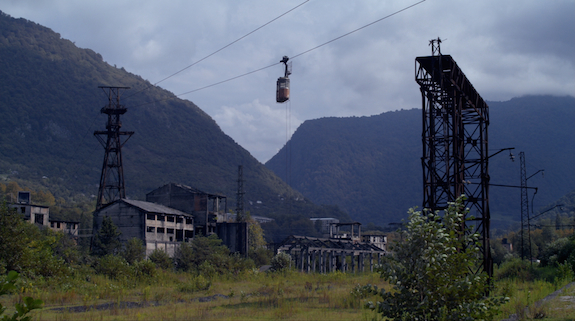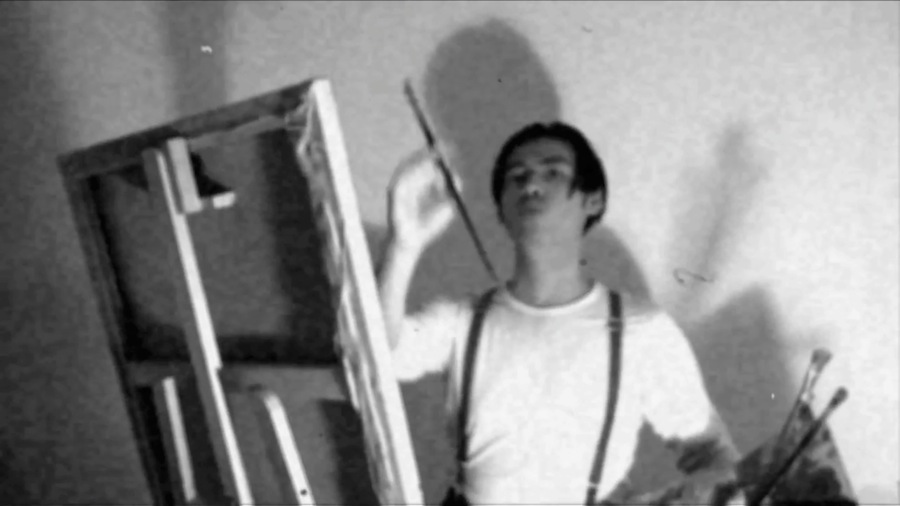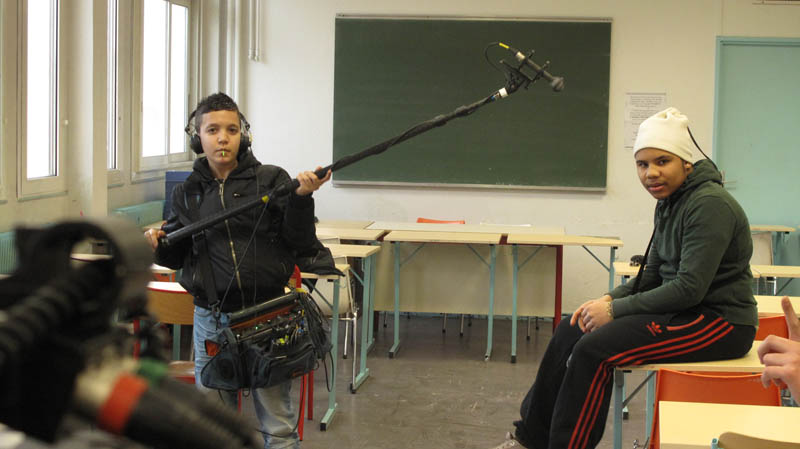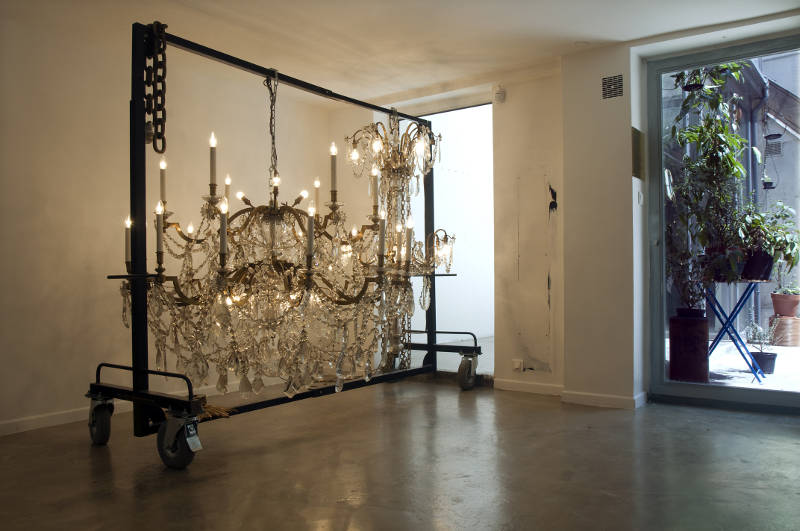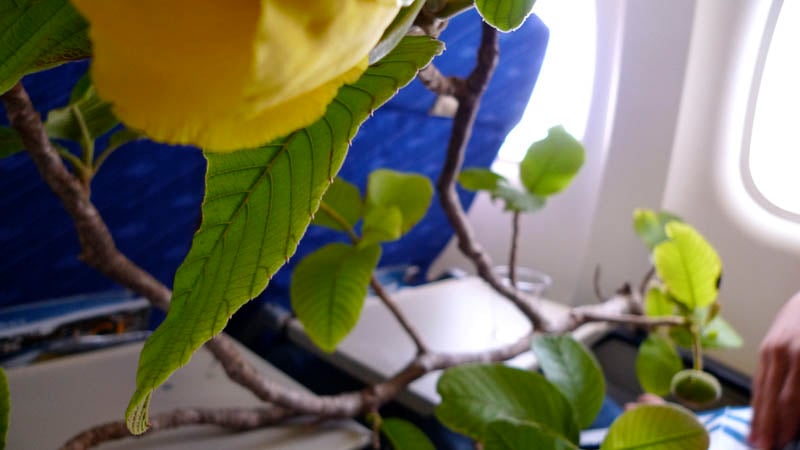
© » KADIST
Tenzing Rigdol
Unhealed by Tenzing Rigdol is a photograph of the artist’s back tattooed with a map of Tibet with the dates of important political events. Each date and region is marked with a needle, a reference to the traditional Chinese medicine method for treating ailments, used to mark the regions and dates of major uprisings and mass protests as a means of encouraging dialogue and to start the recovery process. Millions of Tibetans have died in those protests.
![Elevación [Elevation]](https://kadist.org/wp-content/uploads/2022/09/IMG_escena001_3513-scaled.jpg)
© » KADIST
Ana María Millán
Interested in role-play and videogames, Ana María Millán developed workshops with different communities in order to create characters and scenarios for her animations, often in collaboration with a choreographer. Elevación evokes various narratives inspired by the comicstrip Marquetalia, Raíces de la Resistencia (Marquetalia, Roots of the Resistance) (2011). This comic strip is a memoir of the FARC (Revolutionary Armed Forces of Colombia) guerillas written by Jesús Santrich, one of its leaders who, after the 2016 Peace Agreement, rejoined dissident members of the organization in a clandestine guerrilla splinter group in 2019.

© » KADIST
Tobias Fike & Matthew Harris
Facing one another, each projection screen of the work Food Fight respectively features Tobias Fike and Matthew Harris preparing multi-course meals at a kitchen counter. As the artists dice, mix and plate meals, they begin throwing food at each other—the scene rapidly turning into a battlefield made of food projectiles, broken glasses, and dirty settings. Disruptive, playful, and aggressive, the protagonists’ actions fuse the spontaneity and innocence of children’s games with the force and reality of adults.

© » KADIST
Wang Tuo
The Interrogation is a video constructed entirely from still film photography and photoshop collage — playing out as a photomontage along with a voiceover. By using still photography instead the moving images, Wang Tuo creates room for the audience’s imagination. The voiceover produces a rhythm to enhance the tensions in the work.

© » KADIST
Pratchaya Phinthong
Pratchaya Phinthong’s work has explored the mineral and karmic economies of Laos, a country that shares language, beliefs, and a long border with his own native region of Isaan (Northeast Thailand). The most bombed nation on earth, Laos still bears the physical and mental scars of the U. S. military’s epic aerial offensive, launched largely from bases in Isaan, during the Second Indochina War. Between 1964 and 1973 the US dropped an estimated 250 million cluster bombs on Laos.

© » KADIST
Pratchaya Phinthong
Pratchaya Phinthong’s work has explored the mineral and karmic economies of Laos, a country that shares language, beliefs, and a long border with his own native region of Isaan (Northeast Thailand). The most bombed nation on earth, Laos still bears the physical and mental scars of the U. S. military’s epic aerial offensive, launched largely from bases in Isaan, during the Second Indochina War. Between 1964 and 1973 the US dropped an estimated 250 million cluster bombs on Laos.

© » KADIST
Aziz Hazara
Youthfulness and gestures of play are central to Aziz Hazara’s practice. The artist uses these mechanisms as a lens to give pause to the behaviours of children as foreboding reflections of the enduring and all-pervasive effects of conflict and war. In the short video Rehearsal the artist documents two young Afghan boys imitating the guttural rattling of an automatic rifle, play-shooting in the field in front of them, and swivelling as if to suggest the gun is mounted.

© » KADIST
Imran Qureshi
At first glance, This Day by Imran Qureshi appears to be an energetic, gestural painting reminiscent of Action Painting from the mid-20th century. But upon closer inspection, highly detailed floral elements reveal themselves amongst the bold red brushstrokes. The botanical motifs in Qureshi’s work represent life and regeneration while the red paint refers to death and mortality.

© » KADIST
Erbossyn Meldibekov
Game (Six Pieces) by Erbossyn Meldibekov is inspired by the popular Rubik’s cube puzzle and is composed of three colors (red, green and white) instead of six, referencing the colors of the Afghan flag. The work provides a revisionist interpretation of the legacy of The Great Game (the original 19th-century standoff between Russian and British empires over Afghanistan), and Afghanistan’s position as a centerpiece of the longstanding War on Terror, (the military campaign led by the United States and their allies against organizations and regimes they identified as terrorists after 9/11). Game (Six Pieces) mobilizes dark humor and irony to illustrate the complex and unstable relationships between communism, Islam, and American and British imperialism.

© » KADIST
Karan Shrestha
After the decade-long conflict (1996-2006) that ended with Nepal becoming a Federal Democratic Republic, political unrest and weak governance continued to mark the country’s future as daily life repeatedly witnessed ruptures. From accessing essentials to employment, education, compensation, legal justice, health facilities, and human rights, the people of Nepal have been forced to wait. Meanwhile by Karan Shrestha records moments of impasse as the post-conflict period dragged on.

© » KADIST
Aung Ko
They burn our village by Aung Ko is part of the artist’s daily visual diary as an attempt to process and note what has been happening in Myanmar while he is being exiled, following the military takeover of the government in February 2021. Almost two years ago, Myanmar’s military ousted the democratically elected government of Aung San Suu Kyi and seized power in a coup. Since then, the country has descended into turmoil.

© » KADIST
Võ An Khánh
In Extra Curriculum Political Science Class 7/1972 , a group of women walk bare-foot and single file towards Dat Mui Mangrove in Ca Mau Province to attend ‘political science class’. These women wear headdress to protect their identities because they are spies placed strategically in the South by the Viet Cong. These classes of the ‘National Liberation Front for Southern Vietnam’ took place in the mangrove swamp in makeshift wooden huts where they would learn more of the political points of view of their forces and the changes in military situations across the country.

© » KADIST
Kudzanai-Violet Hwami
This painting is the direct result of the artist’s research into her roots. Kudzanai-Violet Hwami sought to find a way to immerse herself in present-day Zimbabwe, spending a month at an artist-run space Dzimbanhete on the outskirts of Harare and living with a traditional healer. According to the artist, the experience left her feeling othered by the inability to fully integrate herself into the place she called home.

© » KADIST
Ali Eyal
Formed from pillowcases, each of which contains an embroidered calligraphic text as well as drawings depicting dreams, Ali Eyal’s Painting Size 80 x 60 cm is part of a long-term project which records and indexes such dreams. “I rode on my cousin’s back, laughing until the heaviness of my body weighed his to the floor. At the time I was with him on their large farm that he always dreamed of visiting.

© » KADIST
Baktash Sarang Javanbakht
Drawing & Print (Drawing & Print)
The series refers to the militarization in Iran and surrounding countries and criticizes it by naming it reproduction of failure. Baktash Sarang was born 1981 in Tehran, Iran. He studied at Azad University, Tehran and then graduated from ESADS, Strasbourg in 2009.

© » KADIST
AES+F
The Last Riot was originally created for Venice Biennale in 2007. In reference to Baroque Painting tradition and Chiaroscuro, this video installation imagines a dystopian virtual world where bodies removed from conscience and emotion exist weightlessly in a cyber paradigm. Light, shadow and digital manipulation slate a post-apocalyptic world where young teens enact conflict as ritual.

© » KADIST
James T. Hong
Taiwan WMD (Taiwan and Weapons of Mass Destruction) is part of a long-term research started in early 2010 on the history and aftermath effects of Japanese biological and chemical warfare in China during WWII, as well as the unknown history of Taiwan’s nuclear program. T. Hong’s research is not only an effort to revisit a dark time that complicates certain histories, but more importantly an investigation of how violence is enacted in the name of rationality.

© » KADIST
Lawrence Abu Hamdan
In May 2014, Israeli soldiers shot and killed two teenagers, Nadeem Nawara and Mohamad Abu Daher in occupied Palestine (West Bank). Through the Forensic Architecture program, the human rights organization Defence for Children International worked with Abu Hamdan to investigate the incident. The case hinged upon an audio-ballistic analysis of the recorded gunshots to determine whether the soldiers had used rubber bullets, as they asserted, or broken the law by firing live ammunition at the two unarmed teenagers.

© » KADIST
Ha Tae-Bum
Ha Tae-Bum’s “White” series, started in 2008, begins with photographic images from the mainstream media depicting sites of conflict or crisis. The artist eliminates human presence, miscellaneous details, and all color from the images, then “rebuilds” them into quiet, achromatic models with thin white paper. Once complete, the models are photographed in a nearly identical composition as the original image.

© » KADIST
Tom Nicholson
Tom Nicholson’s Comparative Monument (Palestine) engages a peculiar Australian monumental tradition: war monuments that bear the name “Palestine”. Countless of these monuments were built immediately after World War 1 to commemorate the presence of Australian troops in Palestine. The Australian troops had entered Palestine in 1917 after fighting the Turks threatening the Suez Canal with the British, when the main focus was on the European fronts rather than on the Middle East campaign.

© » KADIST
Võ An Khánh
In Mobile Military Medical Clinic 9/1970 , a stretcher carrying an injured solider is being carried through swamp-land towards a makeshift operation table.

© » KADIST
Kristof Kintera
Bad innovation in the name of protection is not a ready-made, but was made entirely by the artist, representing a stroller. Its interior is shielded and designed for babies in the case of conflict. Camouflaged, it resembles a small tank.

© » KADIST
Pavel Wolberg
A young settler girl, dressed in a bridal outfit for Purim, stands in a street in Hebron waiting, perhaps for her parents or other children to join her. In the background three soldiers scan the buildings and the rooftops for threatening presences. Turning her back to the soldiers, the little girl pays no attention to what surrounds her.

© » KADIST
Baris Dogrusöz
The series of works gathered under the title Heure de Paris combines footage of Turkey from Turkish and French media reportage from the 1980s. Using archival material, including maps, television emissions, footage, Dogrusöz’s brings to light the state monopoly on radio and TV that ended in 1994 and the impact this had on documentation and reportage in this period. In Heure de Paris: The map and the territory , Dogrusöz collected and displays all the occurrences where maps of Turkey, frequently used in public French television, were reported.

© » KADIST
Benvenuto Chavajay Gonzalez
Jardín (2013) refers to environmental destruction, specifically the preponderance of disposable plastics, as well as Medellín’s long history of dangerous conflict; it was once considered the most violent city in the world because of the drug trafficking there. This floor sculpture consists of shoes made of river stones, strung with flip-flop straps. Here, Chavajay plays the natural (found stones) against the synthetic (plastic), heavy against light, hard against soft, revealing the irony of their fusion and the impossibility of their alleged function as shoes.

© » KADIST
Elena Tejada-Herrera
Las Bambas by Elena Tejada-Herrera takes the name of a copper mine in the Andean department of Apurímac, Peru. The operations of this mining project were resisted by the local peasant communities, whose protests forced it to paralyze its operations. As of 2023, this is the most serious unresolved social conflict in the country.

© » KADIST
Jessie Stead
Jessie Stead’s Punched Interlude works are made out of found police barricade tape that she punches holes in and then runs through a music box, the music is composed by her as audible reflection on barricades and no go zones throughout the city of New York in area of Donald Trump. The music box is attached to a gum ball machine globe which acts as a resonator, amplifying the music that results from the punched holes.

© » KADIST
Fang Lu
No World is an action-filled video work filmed inside an abandoned museum in the Songzhuang area outside Beijing. Without using any dialogue, Lu created an artificial scenario where she instructed actors with a list of tasks to gesturally mime scenes from news and journalistic images outside China. Through an intuitive self-trained mimicry, these acts simultaneously became moves in a game as well as a daily routine.

© » KADIST
Douglas Gordon
Douglas Gordon’s single-channel video The Left Hand Can’t See That The Right Hand is Blind, captures an unfolding scene between two hands in leather gloves—at first seemingly comfortable to be entwined, and later, engaged in a struggle. As suggested by the work’s title, each of the hands assumes a character with a distinct personality, as if we were witnessing a lovers’ quarrel and embrace, or the embodiment of opposing forces of an internal struggle. Gordon has previously created performance-based works depicting his own body or parts of it—arms, hands, fingers, eyes—usually enacting simple, repetitive movements.
Pratchaya Phinthong
Pratchaya Phintong’s works often arise from the confrontation between different social, economic, or geographical systems...
James T. Hong
James T...
Lawrence Abu Hamdan
What are the political implication of our sounds and voices? How is it heard and used for or against us? These are questions posed by Lawrence Abu Hamdan (b...
Wang Tuo
Through film, performance, painting, and drawing, artist Wang Tuo interweaves disparate realities through archives, modern history, myth, and literature...
Aung Ko
Aung Ko works with painting, film, installation, and performance...
Ha Tae-Bum
Ha Tae-Bum (b...
Pavel Wolberg
Pavel Wolberg studied photography at the Camera Obscura School of Art in Tel Aviv...
Tenzing Rigdol
Tenzing Rigdol is a contemporary Tibetan artist whose work ranges from painting, sculpture, drawing and collage, to digital, video installation, performance art and site-specific pieces...
Erbossyn Meldibekov
Through drawing, installation, painting, photography, and video, Erbossyn Meldibekov’s practice examines architecture, monumentality, and value systems in the public domain...
Aziz Hazara
Aziz Hazara works across various media such as video installation, photography, sound, and sculpture...
Ali Eyal
Artist Ali Eyal’s practice aims to explore the complex relationship between community and politics using different media such as video, installation, photography, and painting...
Tom Nicholson
Tom Nicholson is trained in drawing, a medium which he has used to think about the relationships between public actions and their traces, between propositions and monuments, and between writing and images...
Benvenuto Chavajay Gonzalez
Benvenuto Chavajay’s body of work includes sculpture, interventions into objects, installation, performance, and painting...
Elena Tejada-Herrera
Elena Tejada-Herrera is a key figure at the intersection of feminist, performance, and technological art in Peru...
Jessie Stead
Jessie Stead is as much a musician as she is a visual artist...
Imran Qureshi
Pakistani artist Imran Qureshi’s practice revives 16th century Mughal miniature painting...
Tobias Fike & Matthew Harris
Artists Tobias Fike and Matthew Harris regularly work together on collaborative projects...
Karan Shrestha
Karan Shrestha’s practice portrays the social tensions and historical complexities embodied in the social fabric of Nepal...
Douglas Gordon
- location: Berlin, Germany
- year born: 1966
- gender: male
- nationality: Scottish
- home town: Glasgow, United Kingdom
Kudzanai-Violet Hwami
UK-based artist, Kudzanai-Violet Hwami was born in Gutu, Zimbabwe in 1993 and lived in South Africa from the ages of 9 to 17...
Kristof Kintera
Kristof Kintera is a major artist of the contemporary Czech scene also with international acclaim...
Fang Lu
Fang Lu uses intimacy as a place for self-expression in her videos and draws out mundane moments from everyday life as a strategy to heighten one’s awareness of existence from the rest of the world...
-
2000-2009
Pavel Wolberg
2004A young settler girl, dressed in a bridal outfit for Purim, stands in a street in Hebron waiting, perhaps for her parents or other children to join her...
Douglas Gordon
2004Douglas Gordon’s single-channel video The Left Hand Can’t See That The Right Hand is Blind, captures an unfolding scene between two hands in leather gloves—at first seemingly comfortable to be entwined, and later, engaged in a struggle...
Kristof Kintera
2007Bad innovation in the name of protection is not a ready-made, but was made entirely by the artist, representing a stroller...
-
2010-2019
Võ An Khánh
2010In Extra Curriculum Political Science Class 7/1972 , a group of women walk bare-foot and single file towards Dat Mui Mangrove in Ca Mau Province to attend ‘political science class’...
Ha Tae-Bum
2010Ha Tae-Bum’s “White” series, started in 2008, begins with photographic images from the mainstream media depicting sites of conflict or crisis...
James T. Hong
2012Taiwan WMD (Taiwan and Weapons of Mass Destruction) is part of a long-term research started in early 2010 on the history and aftermath effects of Japanese biological and chemical warfare in China during WWII, as well as the unknown history of Taiwan’s nuclear program...
Tom Nicholson
2012Tom Nicholson’s Comparative Monument (Palestine) engages a peculiar Australian monumental tradition: war monuments that bear the name “Palestine”...
Tobias Fike & Matthew Harris
2013Facing one another, each projection screen of the work Food Fight respectively features Tobias Fike and Matthew Harris preparing multi-course meals at a kitchen counter...
Benvenuto Chavajay Gonzalez
2013Jardín (2013) refers to environmental destruction, specifically the preponderance of disposable plastics, as well as Medellín’s long history of dangerous conflict; it was once considered the most violent city in the world because of the drug trafficking there...
Baktash Sarang Javanbakht
Drawing & Print
2014(Drawing & Print) The series refers to the militarization in Iran and surrounding countries and criticizes it by naming it reproduction of failure...
Baris Dogrusöz
2014The series of works gathered under the title Heure de Paris combines footage of Turkey from Turkish and French media reportage from the 1980s...
Lawrence Abu Hamdan
2016In May 2014, Israeli soldiers shot and killed two teenagers, Nadeem Nawara and Mohamad Abu Daher in occupied Palestine (West Bank)...
Imran Qureshi
2017At first glance, This Day by Imran Qureshi appears to be an energetic, gestural painting reminiscent of Action Painting from the mid-20th century...
Erbossyn Meldibekov
2017Game (Six Pieces) by Erbossyn Meldibekov is inspired by the popular Rubik’s cube puzzle and is composed of three colors (red, green and white) instead of six, referencing the colors of the Afghan flag...
Karan Shrestha
2017After the decade-long conflict (1996-2006) that ended with Nepal becoming a Federal Democratic Republic, political unrest and weak governance continued to mark the country’s future as daily life repeatedly witnessed ruptures...
Jessie Stead
2017Jessie Stead’s Punched Interlude works are made out of found police barricade tape that she punches holes in and then runs through a music box, the music is composed by her as audible reflection on barricades and no go zones throughout the city of New York in area of Donald Trump...
Tenzing Rigdol
2019Unhealed by Tenzing Rigdol is a photograph of the artist’s back tattooed with a map of Tibet with the dates of important political events...
Ana María Millán
2019Interested in role-play and videogames, Ana María Millán developed workshops with different communities in order to create characters and scenarios for her animations, often in collaboration with a choreographer...
Kudzanai-Violet Hwami
2019This painting is the direct result of the artist’s research into her roots...
Elena Tejada-Herrera
2019Las Bambas by Elena Tejada-Herrera takes the name of a copper mine in the Andean department of Apurímac, Peru...
-
2020-2029
Pratchaya Phinthong
2022Pratchaya Phinthong’s work has explored the mineral and karmic economies of Laos, a country that shares language, beliefs, and a long border with his own native region of Isaan (Northeast Thailand)...
Pratchaya Phinthong
2022Pratchaya Phinthong’s work has explored the mineral and karmic economies of Laos, a country that shares language, beliefs, and a long border with his own native region of Isaan (Northeast Thailand)...







